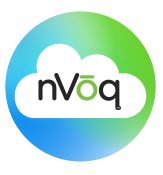Overview
Introduction
Welcome to the nVoq API How-To documentation. Each of the How-To pages walks you step by step through the
process of implementing the most commonly used API functionality. The examples are illustrated in several
programming languages and complete sample code is provided at the end for simply copying and
pasting working code into your IDE or editor to run yourself.
Here's a link to the nVoq
API documentation.
API Functionality
The nVoq API provides everything you need for secure scalable continuous speech recognition, grammar-based
speech recognition (command and control), and desktop process automation. In addition to these core functions,
the API provides access to the full range of enterprise class administrative capability which includes user and organization
administration, and subscription management. nVoq provides a flexible multi-tenant platform in which you
can model your organization to share common organizational administrative information (e.g. custom vocabulary,
automations, and sentence modeling).
We chose Web Services and Web Sockets to provide the most flexible solution possible. So,
whether you are developing speech enabled applications for Windows, iOS, Android, or Raspberry Pi, you will find
what you need in our API. C#, Objective-C, Swift, Go, Python, Java, and C++ are all welcome here. If your
platform supports Web Services, it will work with our API.
We have exposed the Open API yaml for our API's at the top of each section of the
API documentation. Use this Download OpenAPI Specification button to retrieve this document.
Using
Postman Version 7.10 and up you can generate sample code that invokes the web service methods
from many mainstream programming languages.
If you are developing browser-based applications, consider the impact of
Cross-Organization Resource Sharing (CORS) constraints
on your application deployment. You will not be able to invoke our HTTP Web Services from your browser until our server is configured
to allow requests from your domain. Please contact your sales representative for more information.
Dictation
Dictation functionality comes in two flavors: HTTP and WebSocket. HTTP dictation works best for back-end
transcription and where required by tightly constrained networking environments. The WebSocket API provides low
latency access to the dictation service that works great for real-time dictation where the user is dictating and
receiving the corresponding transcription as they speak. The dictation How-To documentation can be found here:
Matching
Matching is similar to dictation in that audio is sent to the server and results are returned. The main difference is
that matching returns answers from a list of choices rather than the free flowing text of continuous speech recognition.
Matching functionality is also available in two forms. For local, always on, command and control such as
"start dictation", we provide a client library for grammar based matching. For more complex grammars such as
navigation choices within a large radiology application, an HTTP API is available for accessing cloud hosted
matching functionality. The cloud-based matching service How-To can be found here:
Administration
The nVoq API provides the administrative capability you need to scale your deployments to thousands of users. You can create hierarchical
organizations that fit your deployments and simplify the process of administering a large enterprise user base. The How-Tos at the links
below will get you started.
Additional How-To Docs
When You're Ready to Start
If your organization has not already been in contact with our Sales team, please complete this short form on the
Developer Registration Page
and we will reach out to you regarding a user account and development with our APIs.
Once you have an account, you must change your password before the account can be used for API calls.
Here’s the
API Developer key resources site that will help you get started, better understand the dictation process, provide links to code samples, and provide links to API documentation.
If you have any questions, please contact us at support@nvoq.com.
License
The sample code provided in these how-to documents are licensed under an MIT-style licence, allowing you the freedom to
work with these samples as it best fits your project. That license can be found
here.
© 2023 nVoq Inc. | Privacy Policy
